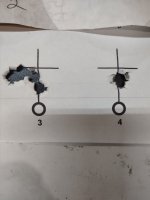I've been shooting AR's for 30 years, have built a ton of them. My target AR15 (223) shoots 3/8", 100 yard groups pretty easily and consistently from the magazine.
Built another AR10 308 with top tier products... because I'm pigheaded and won't give up.
Matched AERO upper and lower
Nightforce ATACR 7-35 F1 Mil C
ARC M Brace mount
Midwest industries FF handguard
SLR adjustable gas block, 9 oz. buffer
Triggertech Diamond trigger
Craddock Precision custom Bartlien heavy 18" barrel
Rubber City Armory bolt carrier with JP high pressure bolt headspaced to the barrel.
Handloading using Sierra, Berger 168, 169 and 175 hpbt, Lapua brass, etc. etc.
Probably pounded 5-6 hundred dollars of components into the berm......
All Magazine fed...because that's how it's supposed to shoot.
Every group always looks like the one on the LEFT.....
TODAY out of frustration I had 5 rounds left exactly like the ones in the left target......and for some unknown reason I decided to single feed them. I pushed a round into the chamber and dropped the bolt release for each one.
Single feed is on the right!!!!!! WTF. Seriously. 0.142" 5 shot group.
Why the difference? Is it a result of the violent forces of the BCG slamming back and forth? Sort of depressing since it's a semi auto......
What is happening during the BCG cycling process that's introducing so much inaccuracy?

Built another AR10 308 with top tier products... because I'm pigheaded and won't give up.
Matched AERO upper and lower
Nightforce ATACR 7-35 F1 Mil C
ARC M Brace mount
Midwest industries FF handguard
SLR adjustable gas block, 9 oz. buffer
Triggertech Diamond trigger
Craddock Precision custom Bartlien heavy 18" barrel
Rubber City Armory bolt carrier with JP high pressure bolt headspaced to the barrel.
Handloading using Sierra, Berger 168, 169 and 175 hpbt, Lapua brass, etc. etc.
Probably pounded 5-6 hundred dollars of components into the berm......
All Magazine fed...because that's how it's supposed to shoot.
Every group always looks like the one on the LEFT.....
TODAY out of frustration I had 5 rounds left exactly like the ones in the left target......and for some unknown reason I decided to single feed them. I pushed a round into the chamber and dropped the bolt release for each one.
Single feed is on the right!!!!!! WTF. Seriously. 0.142" 5 shot group.
Why the difference? Is it a result of the violent forces of the BCG slamming back and forth? Sort of depressing since it's a semi auto......
What is happening during the BCG cycling process that's introducing so much inaccuracy?

Last edited:



